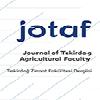Stability Parameters for Yield and Yield Component of the Bread Wheat Genotypes under Various Drought Stress Condition
___
Blum, A. 1988. Plant breeding for stress environments. CRC Press, Boca Raton, FL, 38- 78.Blum, A. 1996. Yield potential and drought resistance: are they mutually exclusive? In: Reynolds M.P., Rajaram S., Mc Nab A. (Eds.) Increasing yield potential in wheat. Breaking the barriers, 90-101.
Clarke, J.M., R.M. De Pauw and T.F. Townley-Smith, 1992. Evaluation of methods for quantification of drought tolerance in wheat. Crop Science 32, 423-428.
Eberhart, S.A. and W.A Russell, 1966. Stability parameters for comparing varieties. Crop. Sci.6: 36-40.
Finlay, K.W. and G.N. Wilkinson, 1963. The Analysis of Adaptation in a Plant Breeding Programme. Aust. J. Agric.Res., 14: 742-754.
Fernandez, G.C.J. 1992. Effective selection criteria for assessing stress tolerance. In: Kuo, C.G. (Ed.) Proceedings of the International Symposium on Adaptation of Vegetables and Other Food Crops in Temperature and Water Stress. Tainan, Taiwan.
Kalaycı, M. 2005. Örneklerle Jump Kullanımı ve Tarımsal Araştırma için Varyans Analiz Modelleri. Anadolu Tarımsal Araştırma Enst. Müd. Yayınları, Yayın No: 21, Eskişehir.
Mardeh, A.S.S., A. Ahmadi, K. Poustini and V. Mohammadi, 2006. Evaluation of drought resistance indices under various environmental conditions. Field Crops Research 98, 222-229.
Öztürk, İ. and K.Z. Korkut, 2015. Effect of Drought Consist of Different Plant Growth on Some Physiological Traits in Bread Wheat (Triticun aestivum L.) Genotypes. 2. International Plant Breeding Congress (2. IPBC), 1-5 Nov., 2015. Antalya, Turkey.
Pfeiffer, W.H. and H.J. Braun, 1989. Yield stability in bread wheat. In J.R. Anderson and P.B Hazel, eds. Variability in Grain Yields. Washington D.C.: John Hopkins Univ. and the Int. Food Policy Res. Inst.
Pirayvatlou, A.S. 2001. Relations among yield potential, drought tolerance and stability of yield in bread wheat cultivars under water deficit conditions. Proceedings of the 10th Australian Agronomy Conference. Hobart, January 29, 2001
Rajaram, S. and M. Van Ginkel, 2001. Mexico, 50 years of international wheat breeding. Bonjean A.P., Angus W.J., (Eds.) The world wheat book: A history of wheat breeding. Lavoisier Publishing, Paris, France, 579-604.
Rajaram, S., H.J. Braun and M. Van Ginkel, 1996. CIMMYT's approach to breed for drought tolerance. Euphytica 92, 147-153.
Lin, C.S., M.R. Binns and L.P. Lefkovitch, 1986. Stability analysis: Where do we stand? Crop Sci., 26: 894-900.
Zadoks, J.C., T.T. Chang and C.F. Konzak, 1974. A decimal code for growth stages of cereals. Weed Res. 14: 415-421.
- ISSN: 1302-7050
- Yayın Aralığı: 3
- Başlangıç: 2004
- Yayıncı: Namık Kemal Üniv. Tekirdağ Ziraat Fak.
Emrah GÜNGÖR, Aydın ALTOP, Ergin ÖZTÜRK, Güray ERENER
Özgür SAĞLAM, Ali Arda IŞIKBER, Hasan TUNAZ, M. Kubilay ER, Fatih BAHADIR, Recep ŞEN
Yordan MARCHEV, Radka NEDEVA, Dimitrinka KRUSHEVA, Nadezhda PALOVA
Murat DEVECİ, Evren CABİ, Levent ARIN, Ozcan YAVAS
Saanen Keçilerinde ?- Laktoglobulin (?-LG) Geni Ekzon 7 Polimorfizmi ve Süt Verimi ile İlişkisi
Turgay TAŞKIN, Çağrı KANDEMİR, Nedim KOŞUM, Güldehan BİLGEN, Raziye IŞIK
Hristo STOYANOV, Valentin BAYCHEV, Gallina MIHOVA
Effects of Grafting on Organic Seedling Quality and Tomato Production in Greenhouse
GÖLGEN BAHAR ÖZTEKİN, YÜKSEL TÜZEL
The Species of Superfamily Chalcidoidea - Parasites of Aphidophagous Hoverflies
